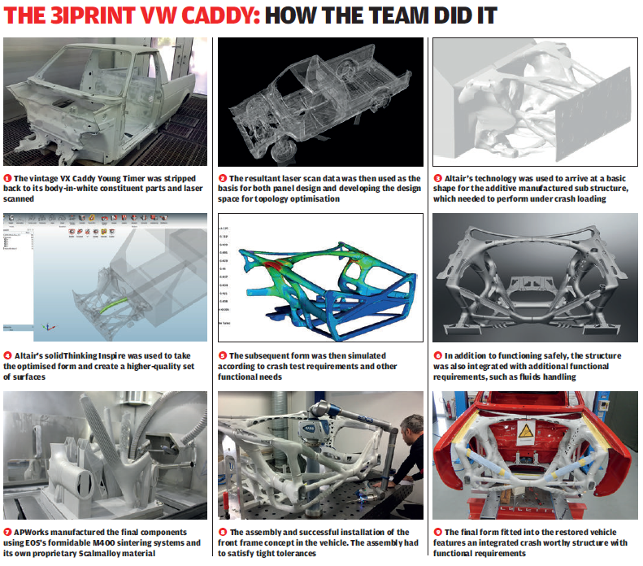
The 3i-PRINT project is a collaborative engineering platform initiated by csi entwicklungstechnik, a Germany-based development partner of the automotive industry. Bringing together other team members – including Altair, Airbus APworks, EOS and automotive and aerospace component manufacturer Gerg – its goal is to demonstrate the potential of industrial 3D printing or additive manufacturing (AM) within the automotive industry.
However, this goal goes beyond structural mechanics and lightweight construction, which is typically considered what AM offers, to explore how a structural component that brings together as many technical features as possible with as few components as possible – will result in added value, particularly beneficial in the construction of vehicles.
As a demonstrator, the 3i-PRINT project team created a new frontend structure to be fitted within a Volkswagen Caddy concept vehicle.
Key considerations
In view of the growing trend towards electrification in the automotive sector, for example of drive train and actuators, heat management as well as the reduction of design space and overall weight were crucial points when designing the front-end section. Moreover, structural requirements relating to vehicle safety, performance and comfort needed to be addressed. Accordingly, parts of the additively manufactured front are load-bearing structures that include details for both active and passive cooling – for example with a channeled airflow to cool batteries and brake systems.
In addition, functions linked to heat management, passive safety, and fluids storage have been integrated in the organic, load-driven design of the front-end module. One example of the integration of additional functions into the structure is the windscreen wiper fluid tank, which could be integrated into the front end structure when conducting the topology optimisation.

Team effort
With these goals in mind, csi – with its experience in developing high quality modules for vehicle bodies, interiors, and exteriors for both manufacturers and suppliers in the automotive sector, – began designing, developing and building the front end structure.
Gerg, with its experience in supplying innovative prototyping and small-scale series for the automotive and aerospace industries, was responsible for connecting the additively manufactured components and the creation of the final frame.
Then Altair, with its focus on the development and broad application of simulation technology to synthesise and optimise designs and processes, used its software solutions to design, optimise, simulate and develop the structure.
After the successful simulation and design of the concept, APWorks, which is a subsidiary of Airbus and very familiar with state-of-the-art manufacturing processes, took care of the final dimensioning of the components and handled the actual additive manufacturing of the structural elements.
When printing the front end, APWorks relied on a system developed by EOS, a supplier of industrial 3D printing technology. Metal powder specialist Heraeus supplied and qualified the high-strength aluminum alloy Scalmalloy, developed by APWorks, to manufacture the components.
APWorks provided support for the printing process by developing the ideal printing parameter sets for the EOS M 400 system.
Final result
With the finished structure fitted into the VW Caddy, this project successfully demonstrates the possibilities of AM over traditional manufacturing methods.
Stefan Herrmann, responsible for light weight design within the body in white team at csi, says: “We are proud to present the Caddy with an exemplary new additively manufactured front end structure.
The new structure and the contrast between old and new impressively demonstrates the potential that 3D printing and functional integration offer, particularly for the automotive industry.
“I would also like to emphasise the agile, time-efficient route from the initial idea to the fully converted vehicle, which was completed within only nine months. Each of the participating companies is a leader in its field. The outstanding collaboration and combined expertise has made the 3i-PRINT project a resounding success.”
Industrial 3D printing in the automotive industry
Default







